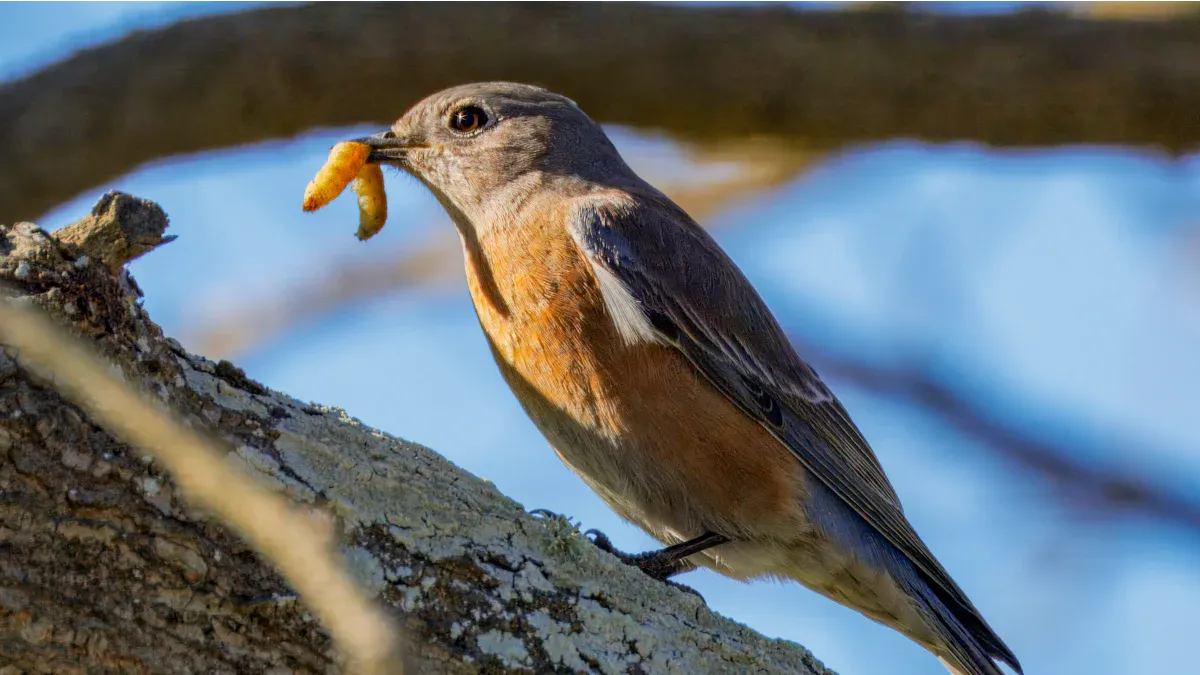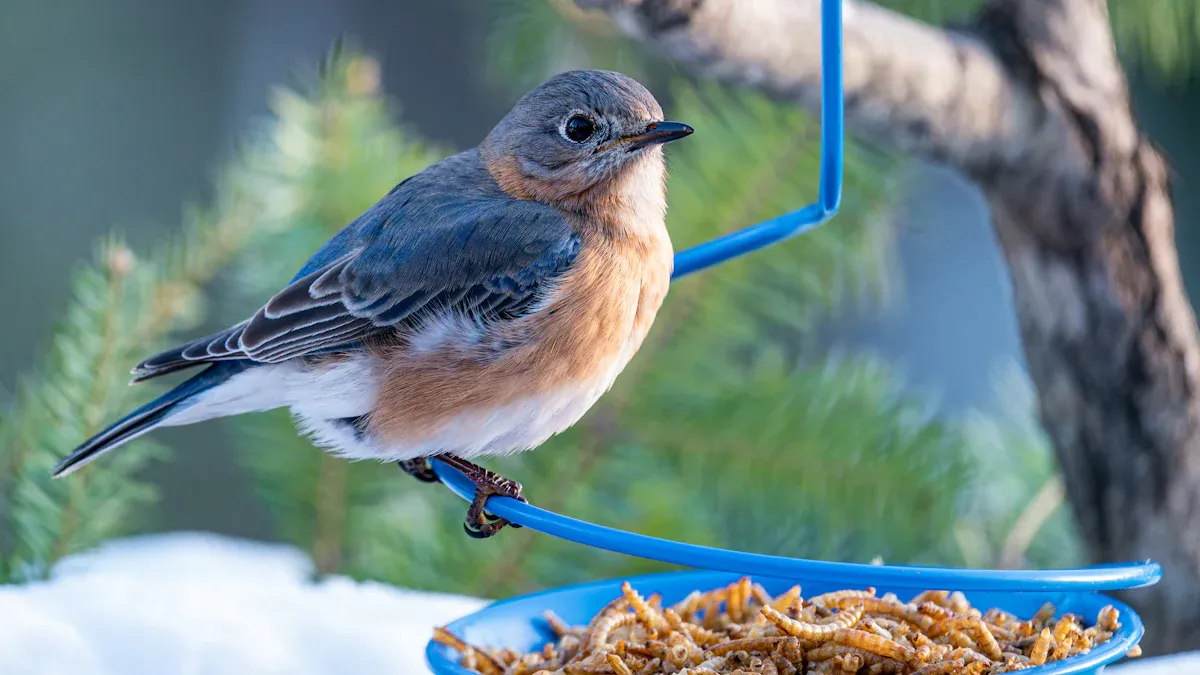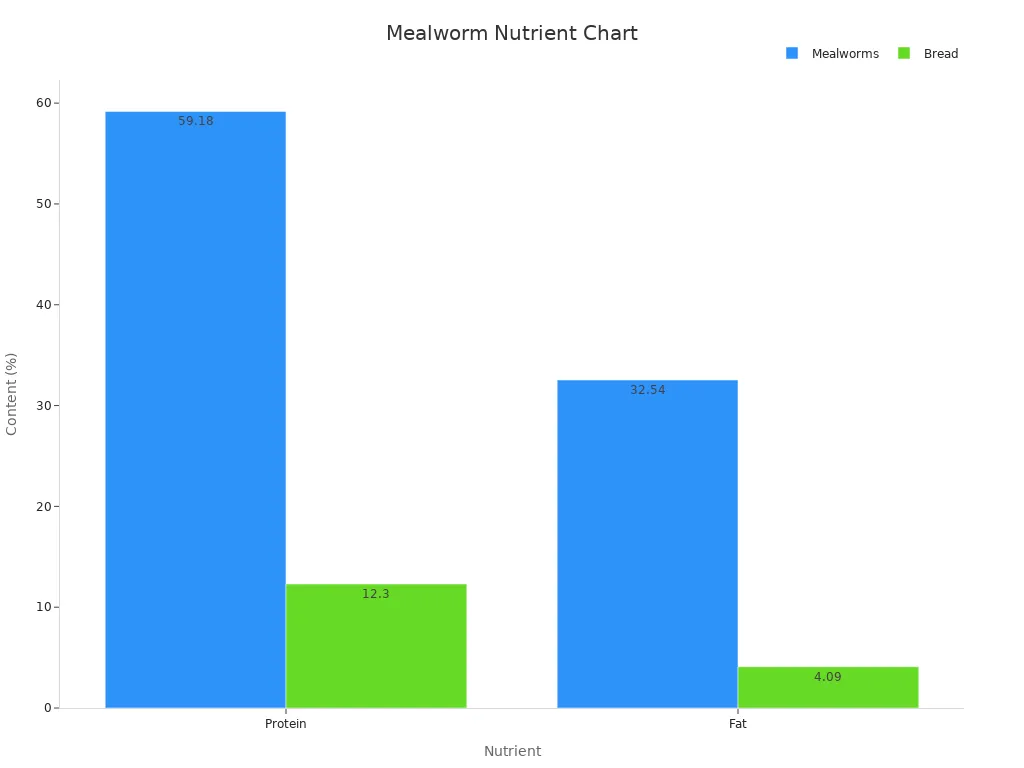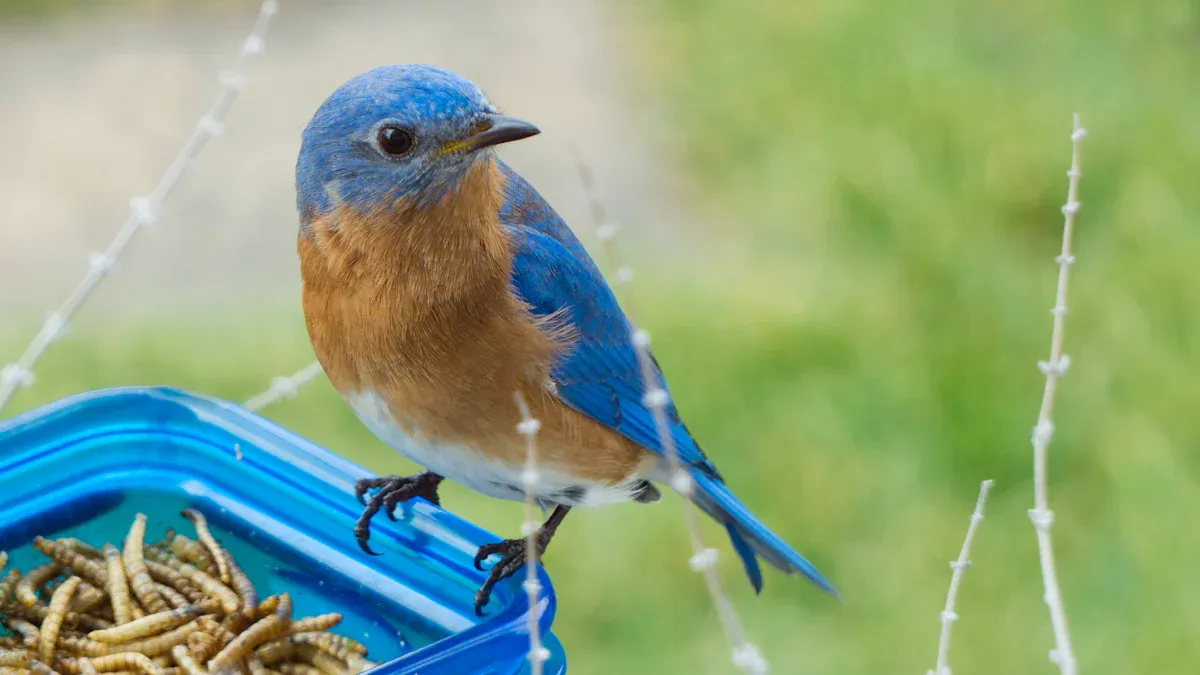
Bluebirds love a tasty treat, especially when they find dried mealworms for bluebirds in a feeder. These little snacks offer the nutrition bluebirds crave. They help birds stay healthy and strong. During breeding or migration, bluebirds need extra support. Many backyard birders see more bluebirds visit when they add mealworms.
Key Takeaways
- Dried mealworms provide bluebirds with high protein, fat, and fiber, helping them stay strong, healthy, and energetic, especially during breeding and cold weather.
- Using the right feeder and placing it in a safe, open spot encourages bluebirds to visit regularly; feed about 100 mealworms once or twice daily for best results.
- Introducing dried mealworms gradually and consistently helps bluebirds learn to enjoy this nutritious treat, attracting more birds and supporting their growth.
Dried Mealworms for Bluebirds: Essential Nutrition

Natural Part of the Bluebird Diet
Bluebirds eat many insects in the wild. They love beetles, caterpillars, and spiders. People often wonder if dried mealworms for bluebirds are a natural choice. While mealworms do not grow in the wild where bluebirds live, these birds find mealworms very tasty and nutritious. Many bird experts say mealworms are a protein-rich snack that bluebirds enjoy. When bluebirds spot a feeder with mealworms, they often visit again and again. This makes dried mealworms a smart way to attract bluebirds to any backyard.
Tip: Place a small amount of dried mealworms in your feeder at first. Bluebirds will quickly learn where to find this delicious treat.
High Protein, Fat, and Fiber Content
Dried mealworms for bluebirds offer more than just a tasty snack. They pack a powerful punch of protein, fat, and fiber. These nutrients help bluebirds stay strong and healthy. The protein in mealworms helps birds build muscle and grow feathers. The fat gives them energy, especially when the weather turns cold. Fiber keeps their digestion running smoothly.
Here is a quick look at the nutrition in dried mealworms compared to other foods:
| Nutrient | Source / Condition | Value (%) | Notes |
|---|---|---|---|
| Protein | Mealworms grown on brewer’s grains | Up to 59.18 | Highest protein content depending on substrate; significantly increases protein in bread |
| Fat | Mealworms grown on agar–agar gels | 32.54 ± 0.02 | One of the highest fat contents found in larvae depending on substrate |
| Fiber | Mealworms (general) | High | Supports healthy digestion in birds |

Studies show that mealworms have protein and fat levels similar to soybean meal, which is a common protein source for animals. Mealworms are also easier for bluebirds to digest than many other insects. This makes them a top choice for bird feeders.
Benefits During Breeding and Cold Weather
Bluebirds need extra help during breeding season and when the weather gets cold. Dried mealworms for bluebirds give them the boost they need. When bluebirds raise chicks, they need more protein and energy. Mealworms help parent birds feed their babies and keep them healthy.
- Feeding bluebirds mealworms during breeding season increases the number of chicks that survive.
- Nests with mealworms have fewer parasites, like flies, compared to nests without mealworms.
- Chicks fed with mealworms show stronger immune systems and higher antibody levels.
- Early feeding in the season gives the best results for baby birds.
- Birds that eat mealworms have healthier gut bacteria, which helps them fight off sickness.
Dried mealworms are also perfect for cold months. Bluebirds burn more calories to stay warm. The high fat in mealworms gives them the energy they need to survive chilly nights. Many bird lovers choose our 1kg bag for regular feeding, but smaller 100g and 500g bags are great for beginners. For those with many hungry birds, larger 5kg and 12.55kg bags offer the best value.
Note: Offer dried mealworms in small amounts each day. This keeps the food fresh and helps bluebirds get the most nutrition.
Dried Mealworms for Bluebirds vs. Other Foods
Nutritional Advantages Over Seeds and Fruits
Bluebirds love a variety of foods, but not all snacks are equal. Seeds and fruits offer some nutrition, but they cannot match the protein and fat found in dried mealworms for bluebirds. Dried mealworms contain about 53% protein and 28% fat, making them a powerhouse for energy and growth. Seeds and fruits have much less protein and fat. They also lack the moisture that live insects provide. Bluebirds need a mix of protein, fat, and fiber to stay healthy. Mealworms help fill the gaps that seeds and fruits leave behind.
| Nutrient Component | Dried Mealworms | Live Mealworms | Seeds/Fruits |
|---|---|---|---|
| Protein | 53% | 20% | Lower |
| Fat | 28% | 13% | Lower |
| Moisture | 5% | 62% | Low |
| Fiber | Higher | N/A | Lower |
This table shows why bluebirds benefit from mealworms as part of their diet.
Digestibility and Appeal to Bluebirds
Mealworms are easy for bluebirds to digest. Their soft bodies break down quickly in a bird’s stomach. Young bluebirds, in particular, need food that is gentle on their digestive system. Seeds and fruits can be tough for chicks to eat. Mealworms also taste great to bluebirds. Many birds will pick mealworms over other foods when given a choice.
Bluebirds often return to feeders that offer mealworms because they know they will find a tasty and easy meal.
Why Bluebirds Choose Mealworms
Bluebirds are smart. They look for foods that help them grow strong and stay active. Mealworms give them the protein and fat they need, especially during breeding and cold weather. Birds naturally balance their diet by eating a mix of seeds, fruits, and insects. Still, mealworms stand out as a favorite. When bluebirds spot dried mealworms for bluebirds in a feeder, they often visit more often and bring their friends along. This makes mealworms a top choice for anyone hoping to attract more bluebirds to their yard.
How to Feed Dried Mealworms for Bluebirds

Choosing the Right Feeder and Bag Size
Selecting the right feeder makes a big difference for bluebird visitors. Many bird lovers choose a hopper-style feeder with 1½-inch entry holes. This design helps bluebirds reach their food while keeping out larger birds. Some feeders, like the Erva Bluebird Feeder, use a bright blue color and a central mealworm cup inside a metal cage. Bluebirds feel safe and attracted to these feeders. The sturdy build also keeps out starlings and other unwanted guests.
When picking a bag size, think about how many birds visit and how often you plan to feed them. A 1kg bag of dried mealworms for bluebirds works well for regular feeding. Smaller 100g or 500g bags are perfect for beginners or those with fewer birds. For yards with many hungry bluebirds, larger 5kg or 12.55kg bags offer the best value.
Feeder Placement and Feeding Frequency
Where you place the feeder matters. Set it in a quiet spot, away from busy areas and predators. Bluebirds like open spaces where they can see danger coming. Place the feeder about five feet off the ground for easy access.
Experts suggest feeding once or twice daily, in the morning and early evening. Offer about 100 dried mealworms per feeding. This amount supports nesting pairs and chicks without attracting too many other birds. Mealworms should be a treat, not the only food.
- Feed once or twice a day
- Use about 100 mealworms per feeding
- Place feeder in a safe, open area
Tips for Introducing Dried Mealworms
Bluebirds may need time to try something new. Start by mixing a few dried mealworms with foods they already enjoy. Gradually increase the amount as they get used to the taste. Some people soak dried mealworms in warm water for a few minutes to make them softer and more appealing. Keep the feeding area clean and refill the feeder at the same times each day. Consistency helps bluebirds learn when to visit.
Tip: Patience pays off. Bluebirds will soon recognize your feeder as a reliable source of food.
Dried mealworms for bluebirds make feeding simple. They help bluebirds stay healthy and bring more birds to any yard. Every feeder in 2025 should include them. People who add dried mealworms for bluebirds to their routine support strong, thriving bluebird populations. 🐦
FAQ
Do bluebirds eat dried mealworms all year?
Bluebirds enjoy dried mealworms in every season. They need extra energy in winter and during nesting. Mealworms help them stay healthy all year.
How long do dried mealworms stay fresh?
Dried mealworms last a long time if kept dry and cool. Many people store them in a sealed bag or container for best results.
Can other birds eat dried mealworms too?
Yes! Robins, blackbirds, and wrens also love dried mealworms. Many insect-eating birds visit feeders with mealworms. Bluebirds often bring friends along.


